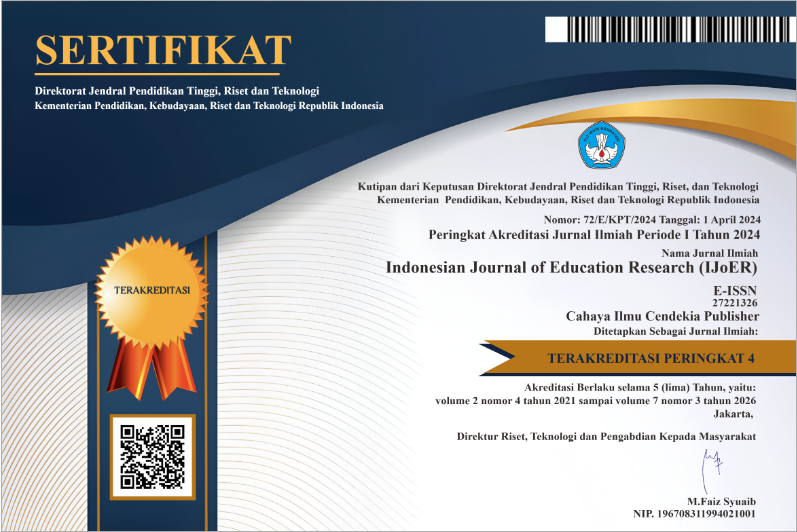Analysis of the Use of Discourse Cohesion Means of Speech Texts of the Regional Government of Jambi Province
Abstract
Purpose of the study: This research aims to describe the means of discourse cohesion and the use of discourse cohesion means in the speech text of the Jambi Province regional government at the plenary session on January 6 2016. The expected benefit of this research theoretically is that it can be used to develop theories about discourse, especially regarding the use of cohesion means in discourse speech text.
Methodology: The method used in this research is a qualitative method with descriptive research type. This research data is in the form of a means of cohesion contained in discourse. Data was obtained by reading the entire discourse of the speech text and marking the found means of cohesion and recording them.
Main Findings: The results of research in the speech text of the regional government of Jambi Province at the plenary session on January 6 2016 found that there were 9 types of cohesive devices, consisting of pronouns, substitutions, ellipsis, conjunctions, repetitions, synonyms, antonyms, hyponyms and collocations. It can be concluded that the most common means of cohesion are pronouns and conjunctions. So, from the results of the analysis that has been carried out, the text of the Jambi Province regional government's speech at the plenary session on January 6 2016 is included in the very cohesive category.
Novelty/Originality of this study: From the results of this research, it can be seen that there has been progress, namely that 9 means of cohesion were found and no non-cohesive means were found. Meanwhile, previous research only found 8 means of cohesion and found several uses of non-cohesive means of cohesion.
References
Charlina and E.Septyanti, “Pemanfaatan media kahoot sebagai motivasi belajar mengikuti kuis wacana Bahasa Indonesia,” GERAM Gerak. Aktif Menulis, vol. 7, no. 2, pp. 79–83, 2019.
Tomo D. R., O. D. Damaryanti, D. A. Rofifah, and M. W. Arifana, “Analisis kesalahan berbahasa indonesia di bidang wacana dalam iklan produk - produk Indonesia,” Bahtera Indones. J. Penelit. Bhs. dan Sastra Indones, vol. 5, no. 2, pp. 192–203, 2020.
Sudaryanto, K. Sugiarto, and M. Restiana, “Wacana grafiti bak truk dalam Bahasa Indonesia, Bahasa Daerah, dan Bahasa Asing,” Deiksis, vol. 2, no. 3, pp. 276–285, 2019.
I. N. Mileh, “Campur kode pemakaian Bahasa Indonesia pada wacana iklan,” Kult. J. Bhs. dan Budaya, vol. 4, no. 1, pp. 35–43, 2020.
O. Rosidin and A. Muhyidin, “Sumpah serapah sebagai perwujudan penghinaan dalam wacana monolog Pilpres 2019,” J. Membaca, vol. 5, no. 1, pp. 53–62, 2020.
N. Lailiyah, F. Kurwidaria, F. I. W, and Sumarlam, “Analisis wacana kritis monolog dalam talk show mata najwa edisi ‘Menanti Terawan,” Efektor, vol. 8, no. 1, pp. 34–44, 2021.
A. S. Wibowo, “Analisis metode penerjemahan Bahasa Mandarin Ke Bahasa Indonesia pada mahasiswa semester 3 Program Studi Bahasa Mandarin S1 Sekolah Tinggi Bahasa Harapan Bersama,” J. Cakrawala Mandarin, vol. 3, no. 1, pp. 1–17, 2019.
N. Aisyah, “Analisis kohesi dan koherensi wacana pada lembar kerja siswa Bahasa Indonesia untuk SMA/MA/SMK/MAK kelas XI,” Jubindo J. Ilmu Pendidik. Bhs. dan Sastra Indones, vol. 4, no. 3, pp. 151–160, 2019.
D. Silaswati, “Analisis wacana kritis dalam pengkajian wacana,” Metamorf. J. Bahasa, Sastra Indones. dan Pengajarannya, vol. 12, no. 1, pp. 1–10, 2019.
Mainingsih, “Kekohesifan Wacana Surat Dinas yang dikeluarkan Oleh Kantor Camat VII Koto Ilir Kabupaten Tebo Provinsi Jambi,” M.S. thesis, FKIP, Universitas Jambi, Jambi, Indoneisa, 2015.
E. Yanti, "Kekohesifan Wacana Oponi Terbitan Harian Jambi Ekspres Edisi Mei Tahun 2014," M.S. thesis, FKIP, Universitas Jambi, Jambi, Indoneisa, 2014.
S. Yuliani and A. Pramitasari, “Kohesi Gramatikal dan Kohesi Leksikal pada Tajuk Rencana Kompas Edisi Oktober 2021,” Natl. Semin. Pendidik. Bhs. Ingg., no. Nspbi, pp. 149–155, 2022, [Online]. Available: https://proceeding.unikal.ac.id/index.php/nspbi/article/view/948
Copyright (c) 2023 Sri Wahyuni

This work is licensed under a Creative Commons Attribution-NonCommercial 4.0 International License.
Authors who publish with this journal agree to the following terms:
- Authors retain copyright and acknowledge that the Indonesian Journal of Education Research (IJoER) is the first publisher licensed under a Creative Commons Attribution 4.0 International License.
- Authors are able to enter into separate, additional contractual arrangements for the non-exclusive distribution of the journal's published version of the work (e.g., post it to an institutional repository or publish it in a book), with an acknowledgment of its initial publication in this journal.
- Authors are permitted and encouraged to post their work online (e.g., in institutional repositories or on their website) prior to and during the submission process, as it can lead to productive exchanges and earlier and greater citation of published work.






.png)
.png)




















